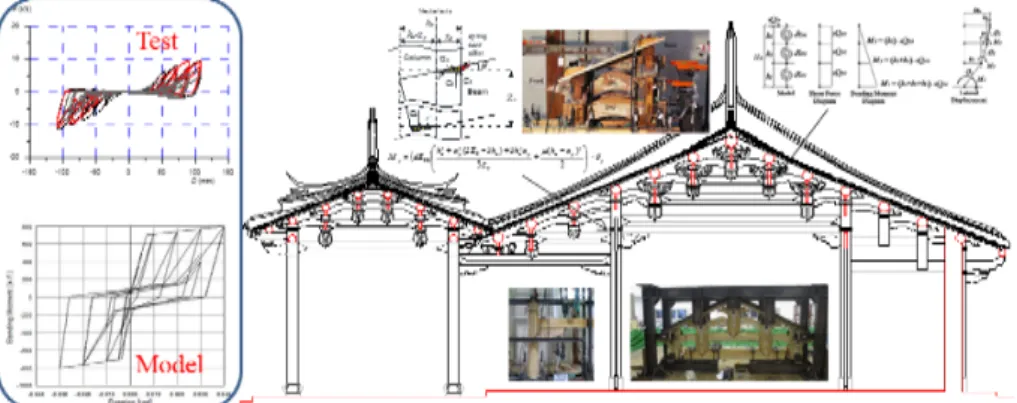ISBN: 978-91-88898-64-7
103
A preliminary numerical analysis study on the oriental historic timber-frame buildings
Sok-Yee Yeo†*, Hsuan-I Hung‡, Yu-Lin Chung‡, and Min-Fu Hsu‡ †Xi’an Jiaotong University, yeosokyee@mail.xjtu.edu.cn
‡National Cheng Kung University, n76061173@gs.ncku.edu.tw, ylchung@mail.ncku.edu.tw, minfu@mail.ncku.edu.tw
The oriental historic timber buildings in Taiwan are mainly composed of timber frames and load-bearing brick walls. As brick walls are generally perceived to be stronger and stiffer than its timber frame counterparts, hence brick walls are often regarded as the primary structural components responsible for countering lateral force during seismic analysis. Due to the complexity of oriental timber frame construction and the lack of proper seismic evaluation methods for this type of traditional structures, the conventional practice is either to neglect or to set all timber connections as hinge, by assuming these connections bear no moment resistance. However, from past experimental results [1-5], it is noted that oriental timber joint connections generally performed more like semi-rigid joints than hinges. The joint stiffness and strength of these traditional joints are not only found to be closely related with joint designs and vertical loads, these timber joints also tend to slip when subjected to lateral force. Thus, if the above observations are not considered during seismic analysis, misunderstanding of the actual deformation pattern might subsequently lead to underestimation of the overall performance of the oriental timber structures.
Base on our team’s past experimental works on the traditional Dieh-Dou type timber structures [2-5], a general understanding on the structural behaviour and fracture patterns of the global and critical joint systems have been established. Although mechanical models derived from the above test observations are generally in good agreement with the static test results, more verifications have to be carried out to find out if the assumptions made are well validated (Figure 1). Hence in this study, the above mechanical models were subjected to two types of ‘real-life’ test trials. In the first instance, the models’ assumptions and calculated parameters were cross-referenced with shaking table tests of a partial Dieh-Dou type timber frame structure to check for its validity. Next, with the use of structural analysis software, these calculated assumptions were further applied onto two existing Dieh-Dou type timber frame monument buildings to generate prediction models (e.g. push-over and time-history analyses) and anticipated weak points of the monument timber buildings. These predicted outcomes are then compared with existing test results and post-reconnaissance earthquake reports for cross validation. Preliminary results from the above test trial revealed that the assumptions made for the numerical analyses are generally in good agreement with the experimental results, and the predicted weak points of the timber structural frame mostly concentrated around the Dou and its adjoining members.
Figure 1: Brief overview of the structural tests conducted and mechanical models proposed.
References
[1] WS King, JY Yen, YN Yen: Joint characteristics of traditional Chinese wooden frames. Engineering structures, 18(8), 635-44, 1996.
[2] W-S Chang, M-F Hsu, K. Komatsu: Rotational performance of traditional Nuki joints with gap I: theory and verification. Journal of Wood Science, 52(1), 58-62, 2006.
[3] W-S Chang, M-F Hsu, K. Komatsu: Rotational performance of traditional Nuki joints with gap II: the behavior of butted Nuki joint and its comparison with continuous Nuki joint. Journal of Wood Science, 53(5), 401-407, 2007. [4] S. Y. Yeo, M.-F. Hsu, K. Komatsu, Y.-L.Chung, and W.-S.Chang: Shaking table test of the Taiwanese traditional
Dieh-Dou Timber Frame. International Journal of Architectural Heritage, 10(5):539–57, 2016a. doi:10.1080/15583058.2015.1009574.
[5] S.-Y Yeo, K. Komatsu, M.-F. Hsu, and Z. Que: Mechanical model for complex brackets system of the Taiwanese traditional Dieh-Dou timber structures. Advances in Structural Engineering, 19(1):65–85, 2016b. doi:10.1177/1369433215618269.
